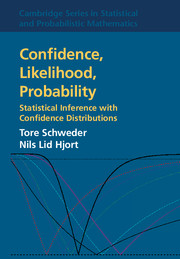Book contents
- Frontmatter
- Dedication
- Contents
- Preface
- 1 Confidence, likelihood, probability: An invitation
- 2 Inference in parametric models
- 3 Confidence distributions
- 4 Further developments for confidence distribution
- 5 Invariance, sufficiency and optimality for confidence distributions
- 6 The fiducial argument
- 7 Improved approximations for confidence distributions
- 8 Exponential families and generalised linear models
- 9 Confidence distributions in higher dimensions
- 10 Likelihoods and confidence likelihoods
- 11 Confidence in non- and semiparametric models
- 12 Predictions and confidence
- 13 Meta-analysis and combination of information
- 14 Applications
- 15 Finale: Summary, and a look into the future
- Overview of examples and data
- Appendix: Large-sample theory with applications
- References
- Name index
- Subject index
10 - Likelihoods and confidence likelihoods
Published online by Cambridge University Press: 05 March 2016
- Frontmatter
- Dedication
- Contents
- Preface
- 1 Confidence, likelihood, probability: An invitation
- 2 Inference in parametric models
- 3 Confidence distributions
- 4 Further developments for confidence distribution
- 5 Invariance, sufficiency and optimality for confidence distributions
- 6 The fiducial argument
- 7 Improved approximations for confidence distributions
- 8 Exponential families and generalised linear models
- 9 Confidence distributions in higher dimensions
- 10 Likelihoods and confidence likelihoods
- 11 Confidence in non- and semiparametric models
- 12 Predictions and confidence
- 13 Meta-analysis and combination of information
- 14 Applications
- 15 Finale: Summary, and a look into the future
- Overview of examples and data
- Appendix: Large-sample theory with applications
- References
- Name index
- Subject index
Summary
The likelihood function is the bridge between the data and the statistical inference when the model is chosen. The dimension of the likelihood might be reduced by profiling, conditioning or otherwise to allow a confidence distribution for a parameter of interest to emerge. We shall now turn this around and develop methods for converting confidence distributions for focus parameters into likelihoods, which we call confidence likelihoods. This is particularly useful for summarising the most crucial part of the inference in a manner convenient for further use, for example, in meta-analyses, as discussed further in Chapter 13. We shall in particular discuss normal conversion methods along with acceleration and bias corrected modifications, and illustrate their uses. Connections to bootstrapping of likelihoods are also examined.
Introduction
The likelihood function is the link between data as probabilistically modelled and statistical inference in terms of confidence distributions or otherwise. This chapter prepares the ground for Chapter 13 on meta-analysis. In a meta-analysis the results of several studies that address a set of related research hypotheses are combined. In its simplest form, the problem is to combine estimates of a common parameter from independent studies, which is traditionally solved by a weighted average with weights obtained from the respective standard errors. This would be optimal if the estimators of the individual studies were normally distributed. From the confidence distributions or confidence intervals of the studies, it might be seen that the normal assumption is far-fetched. Rather than just averaging, it would be better if a pseudo-likelihood could be constructed from the information provided in each of the reports, and combine these by multiplication to a collected pseudo-likelihood. We will call a pseudo-likelihood obtained from a confidence distribution or a confidence interval a confidence likelihood (c-likelihood), and methods for such constructions are developed in the text that follows.
Fisher (1922) introduced the likelihood function as the primary tool for statistical analysis of data. This and the wealth of new concepts, new points of views and new theory constitute the third revolution in parametric statistical inference (Hald, 1998, p. 1), after the first when Laplace (1774) introduced the method of inverse probability and that of Gauss and Laplace, who introduced the least squares method and linear models for normally distributed data in 1809–1812. The likelihood function is a minimal but sufficient reduction of the data.
- Type
- Chapter
- Information
- Confidence, Likelihood, ProbabilityStatistical Inference with Confidence Distributions, pp. 295 - 316Publisher: Cambridge University PressPrint publication year: 2016
- 1
- Cited by



